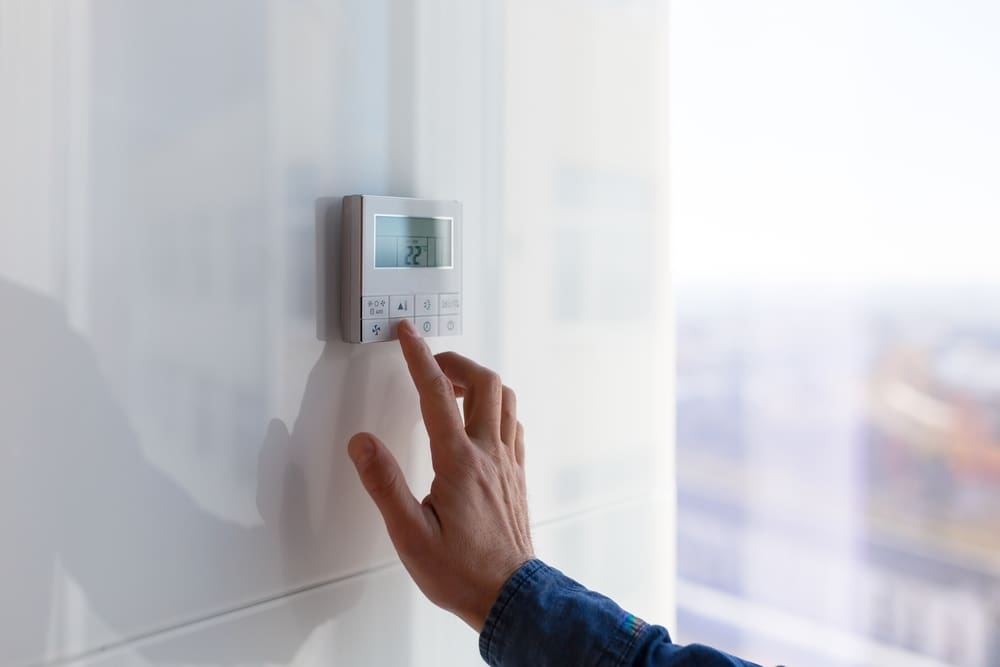At the very center of your centralized heating and indoor air system lies your thermostat. The thermostat is the heart of your home’s HVAC system, providing a direct line to set and stabilize your home’s indoor air temperature. Understanding your thermostat’s temperature control settings is essential to understanding how to facilitate comfort in your home.
There are multiple thermostat models on the market. This makes it difficult to make heads or tails of the best thermostat for your home, and how to utilize thermostat settings successfully. We would be happy to help with that.

Thermostat Settings
All thermostat models have their unique settings and modes. But generally speaking, you’ll want to look out for these features:
- Temperature: Your thermostat will display your home’s actual temperature, as well as the desired temperature you want it to reach.
- Heat/cool modes: These settings are self-explanatory, making use of your heater and air conditioner.
- On mode: This setting will directly interact with your ductwork, continuously circulating air until you shut it off.
You’ll also want to take the time to understand your thermostat’s run, auto, and hold settings. You should also understand:
- Thermostat programming basics
- Energy-efficient thermostat settings
- Thermostat adjustment tips
- Optimal thermostat configurations
- Thermostat usage guidelines
This information can help you understand when and how to set your thermostat to keep your home at the optimal temperature while minimizing energy waste.
What Does Hold Mean on Thermostat Settings?
What does hold mean on thermostat systems? It quickly puts a stop to your pre-programmed settings, instead switching your thermostat to “auto.” This makes it easier to alter things back down to your desired temperature.
This setting is convenient for when your air conditioning cycles need to change on the fly. You can also switch your hold mode off quickly and go back to your pre-programmed settings in run mode.
What Does Auto Mean on Thermostat Systems?
Your thermostat’s auto mode runs based on the discrepancy between your home’s actual temperature and your personally desired temperature.
For instance, your actual air temperature could be in the 80s or 90s around June or July. When you set your thermostat to 76, for example, the auto mode will run until the actual indoor temperature matches your desired temperature.
What Does Run Mean on a Thermostat?
Programmable thermostats extensively use this setting— or, more accurately, multiple settings bundled into one. The run mode will cycle through a variety of different pre-programmed temperature settings, adjusted to your preferences and comfort.
This setting can also be advantageous for energy efficiency. You can adjust cycles for when you’re home and away from home. This can ensure that you’re only using your AC when you need it, saving significantly on energy bills.
How To Set Thermostat Units
When setting your thermostat, take stock of these adjustment tips:
- Read the fine print: Your thermostat’s manual will be the best frame of reference to understand different settings.
- Think about the season: The highest comfortable setting is ideal for warmer months, and a set point of 68 degrees is best for cold months.
- Consider the two-degree rule: In two-story homes, the upper level should be set two degrees lower than the lower level.
- Know how to reset your thermostat: Hold the button down for five seconds to reset your settings.
- Set your schedule: Consider when you will and won’t be home, and adjust your temperature settings accordingly.
Besides understanding your thermostat, take the time to understand your fan. Typically, your thermostat will have two fan settings: “on” and “auto”. The “on” option will deploy the fan to circulate air, without heating or cooling the air.
It’s less energy efficient, so it’s recommended not to run this mode for long. But when you do, it’s effective at flushing air out of a house. Auto mode, on the other hand, will be effective at circulating air in tandem with your heating and cooling settings.
How you use these modes will vary depending on personal preference and how you comparatively weigh your comfort against energy bill costs. As you do, consider the time of year.
Recommended Thermostat Settings for Summer and Winter
Generally speaking, 68 degrees Fahrenheit is the best average indoor temperature for your home in the colder winter weather months. On the flip side, 78 degrees Fahrenheit will be the best average indoor air temperature for your home in the warmer summer months. In any case, you’ll want to find a temperature range that offers the best compromise between comfort and low energy costs.
Your heating and air conditioning will account for a substantial portion of your energy bills. By making optimal use of your thermostat settings, you can stand to save substantially on those costs. Not only that, but you can ensure indoor comfort year-round.
HVAC Technician Thermostat Service
Need to set up a new smart thermostat in your San Diego home?
Call 888-904-4166 to connect with Anderson Plumbing, Heating & Air.